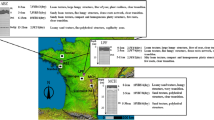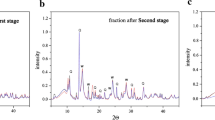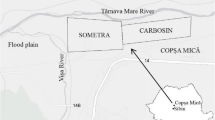Abstract
Background, aim and scope
Technosols form a new soil group in the World Reference Base for Soil Resources (WRB) (FAO, World Soil Resour Rep 132:145, 2006) mainly characterised by anthropogenic parent material of organic and mineral nature and which origin can be either natural or technogenic. The increasing number of sites affected by technogenic materials and their impact on the environment as growing media for plants or as source of pollutants requires an understanding of their functioning and evolution. Among the parameters describing soil functions, the structure is a key property, encompassing physical, chemical and biological soil processes, which is not yet usually studied in Technosols. The presence of high levels of complex technogenic materials and pollutants (polycyclic aromatic hydrocarbons [PAHs] and trace elements) is likely to determine aggregation and induce a specific soil structure. This work was undertaken to test this hypothesis and assess whether technogenic material would contribute to the formation of water-stable aggregates in Technosols.
Materials and methods
The hypothesis was tested using material collected from a former coking plant site. Samples were submitted to water-granulodensimetric fractionation to quantify the water-stable organo-mineral associations in five fractions. Each fraction was analysed for C, PAHs and trace elements. To assess whether specific organo-mineral associations or particles were present in the material, granulometric fractions were observed at a photonic scale, and the main constituents were morphologically and analytically characterised at an electronic scale by scanning electron microscopy (SEM)/energy dispersive X-ray spectroscopy (EDX). The 0–2 µm fraction was also analysed by transmission electron microscopy (TEM)/EDX.
Results
The comparison of the weight distribution of water-stable associations with the texture revealed the presence of water-stable organo-mineral associations in the material. These associations were mostly in the coarse fractions (50–2,000 µm, corresponding to 74% of the total material) and resulted from the association of finer particles (<50 µm). Organic C was mainly of technogenic origin, i.e. hydrocarbons, and it was not distributed homogeneously among the fractions: the coarser fractions (50–2,000 µm) contained 80% of the total organic C and had the highest C/N ratio. The remaining 20% was primarily associated with the 2–20 µm fraction and exhibited a low C/N ratio. PAHs represented 2% of the total soil C and were associated mostly with the 2–20 and 200–2,000 µm fractions. The SEM/EDX analyses showed five main classes of particles: quartz particles, Fe oxide beads, Fe and Al oxides, anthropogenic organic matter mainly associated with S and slag (complex material). The three last classes were mainly present in the 2–20 and 20–50 µm fractions. Gypsum was the main constituent of the 0–2 µm fraction and only a few aluminosilicates (of the montmorillonite group) were observed. Fe, Si and Ca were quantitatively the three major elements but were differently distributed among the fractions. The 200 µm–2 mm fraction presented the highest amounts of trace elements (Cr, Zn, Ba, Pb), with Zn and Pb also being present in the 2–20 µm fraction.
Discussion
This work showed specific water-stable organo-mineral associations in the coking plant material, resulting from both the former industrial activities (i.e. slag) and a neo-aggregation phenomenon involving technogenic organic matter. Characterisation of the constituent elements allowed one to make analogies between the technic material and soils and, thus, to specify the constitution and the fate of organo-mineral associations in such material. Organic matter of industrial origin, i.e. hydrocarbons, was probably involved in these associations, as shown by the high C/N ratio of the coarse fractions and confirmed by the presence of PAHs. Also, uncommon particles were identified, i.e. Fe oxide beads and complex mineral material such as slag residues, resulting from industrial processes at high temperature. Elements like Ca and Fe were recovered at strong concentrations. Fe was present in stable compounds (e.g. Fe oxide beads), but Ca was associated with S and more easily dissolved as observed during the water fractionation process. The fate of the high levels of Fe and Ca present in this soil was probably different to that of natural soils. Other elements, i.e. heavy metals, were present at insufficient rates to act as aggregation factors. However, the material structure would control their localization and availability in the soil particles.
Conclusions
This work showed specific organo-mineral associations in the coking plant material, resulting from both the former industrial coking activity and a neo-aggregation phenomenon involving PAHs. Technic C played a primary role in the aggregation process in the near absence of humic compounds and clay minerals. The approach used allowed one to characterise the material by specifying and localising the primary organic and mineral constituents within the granulometric fractions and the distribution of PAHs and trace elements. Hence, standard methods are proved to be useful to characterise Technosols, allowing the identification of new types of associations.
Recommendations and outlook
Most Technosols are deeply affected by technic materials which control the main processes including aggregation. It is expected that all associations and particles identified in this work confer a specific function to the Technosol, making their characterisation relevant. The evolution of the newly formed associations should be thoroughly studied as they contain several pollutants, particularly PAHs, in higher concentrations than in the bulk soil, in order to assess environmental risk of contaminant release. Thus, monitoring of aggregation will be useful to specify the capacity of Technosols to fulfil certain functions as growing media in the case of urban planning or site remediation.




Similar content being viewed by others
References
Amellal N, Portal JM, Berthelin J (2001a) Effect of soil structure on the bioavailability of polycyclic aromatic hydrocarbons within aggregates of a contaminated soil. Appl Geochem 16:1611–1619
Amellal N, Portal JM, Vogel T, Berthelin J (2001b) Distribution and localisation of polycyclic aromatic hydrocarbons (PAHs) and PAH-degrading bacteria within polluted soil aggregates. Biodégradation 12:49–57
Barriuso E, Calvet R (1992) Soil type and herbicides adsorption. Int J Environ Anal Chem 46:117–128
Barriuso E, Calvet R, Schiavon M, Soulas G (1996) Les pesticides et les polluants organiques des sols. Transformations et dissipations. Etude et Gestion des Sols 3:279–296
Benhabib K, Simonnot MO, Sardin M (2006) PAHs and organic matter partitioning and mass transfer from coal tar particles to water. Environ Sci Technol 40:6038–6043
Calvet R (1989) Adsorption of organic chemicals in soils. Environ Health Perspect 83:145–177
Clément M (1998) Analyse physique des sols (France), Lavoisierth edn. France, Paris, p 275
Drouet T, Herbauts J (2008) Evaluation of the mobility and discrimination of Ca, Sr and Ba in forest ecosystems: consequence on the use of alkaline-earth element ratios as tracers of Ca. Plant Soil 302:105–124
Edwards NT (1983) Polycyclic aromatic hydrocarbon's (PAH's) in the terrestrial environment. A review. J Environ Qual 12:427–441
Fällman A-M (2000) Leaching of chromium and barium from steel slag in laboratory and field tests—a solubility controlled process? Waste Manage 20(2–3):149–154
FAO (Food and Agriculture Organization of the United Nations) (2006) World reference base for soil resources 2006. A frame-work for international classification, correlation and communication. 2nd ed. World Soil Resour Rep 132:145
Feller C, Beare MH (1997) Physical control of soil organic matter dynamics in the tropics. Geoderma 79:69–116
Gobat JM, Aragno M, Matthey W (2003) Le Sol vivant. Bases de pédologie, biologie des sols. Presses polytechniques et universitaires romandes, Lausanne Coll. Gérer l'environnement no 14, 569 p. 2ème édition
Lehmann A (2006) Technosols and other proposals on urban soils for the WRB (World Reference for Soil Resources). Int Agrophys 20(2):129–134
Lozet J, Mathieu C (2002) Dictionnaire de science du sol. Tec et Doc Ed, 575 p
Pignatello JJ (1998) Soil organic matter as a nanoporous sorbent of organic pollutants. Adv Colloid Interface Sci 76(77):445–467
Rossiter DG (2007) Classification of urban and industrial soils in the World Reference Base for Soil Resources. J Soils Sediments 7(2):96–100
Rossiter DG, Burghardt W (2003). Classification of urban & industrial soils in the World Reference Base for Soil Resources. SUITMA 2003: 2nd International Conference of the Working Group ‘Soils of Urban, Industrial, Traffic and Mining Areas’ (SUITMA) of the International Union of Soil Science (IUSS), 09–11 July 2003, Nancy, France
Stella CM, Groenevelt PH, Voroney RP (1990) Biodegradation of gas oil applied to aggregates of different sizes. J Environ Qual 19:257–260
Watteau F, Villemin G, Burtin G, Jocteur-Monrozier L (2006) Root impact on the stability and types of micro-aggregates in silty soil under maize. Eur J Soil Sci 57:247–257
Wilcke W (2000) Synopsis: polycyclic aromatic hydrocarbons (PAHs) in a soil—a review. J Plant Nutr Soil Sci 163:229–248
Acknowledgements
This work was conducted within the framework of the GISFI programme and was supported by the Région Lorraine and the Ministère de la Recherche, France. The authors wish to thank the two reviewers for their relevant comments, Noële Raoult for her help in the collection of the samples and Adeline Bouchard for the technical help in material fractionation. Data were presented at the symposium “Urban and Sub-urban Soils” organised by the SUITMA group at the IUSS Conference held in Philadelphia in 2006.
Author information
Authors and Affiliations
Corresponding author
Rights and permissions
About this article
Cite this article
Monserie, MF., Watteau, F., Villemin, G. et al. Technosol genesis: identification of organo-mineral associations in a young Technosol derived from coking plant waste materials. J Soils Sediments 9, 537–546 (2009). https://doi.org/10.1007/s11368-009-0084-y
Received:
Accepted:
Published:
Issue Date:
DOI: https://doi.org/10.1007/s11368-009-0084-y




